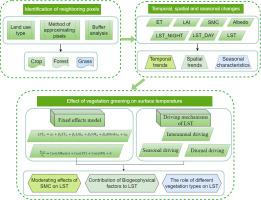Biogeophysical warming effects of vegetation growth in the temperate water-limited region
IF 5.7
1区 农林科学
Q1 AGRONOMY
引用次数: 0
Abstract
Vegetation growth modulates land surface temperature (LST) through biogeophysical processes, yet these mechanisms remain insufficiently quantified. This study analyzed LST variations and their response to key biogeophysical factors—Albedo, evapotranspiration (ET), leaf area index (LAI), and soil moisture (SM)—across forests, grasslands, and croplands from 2000 to 2020. LST exhibited distinct daily (daytime vs. nighttime) and seasonal (growing vs. non-growing seasons) trend patterns. While annual LST remained stable (Slope (S) =0.0014 K/yr, p > 0.05), significant seasonal contrasts emerged: cooling during growing seasons (S = -0.05 K/yr, p < 0.05) and mild warming in non-growing seasons (S = 0.076 K/yr, p > 0.05). Diurnal asymmetry was evident, with daytime LST cooling (S=-0.106 K/yr, p < 0.05) and nighttime LST warming (S = 0.064 K/yr, p = 0.06). Grasslands showed unique warming trends in both annual (S = 0.093 K/yr, p = 0.08) and non-growing seasons (S = 0.22 K/yr, p < 0.05), contrasting with cooling in croplands and forests. The reduction in daytime LST was primarily driven by ET, contributing -0.08 K/yr, while the increase in nighttime LST was mainly regulated by Albedo, with a contribution of 0.07 K/yr. During growing seasons, SM was the key driver of cooling, contributing -0.028 K/yr. In contrast, LST warming in the non-growing seasons was co-regulated by Albedo (0.038 K/yr) and LAI (0.059 K/yr). Compared to croplands and forests, grasslands exhibited increasing LST in annual and non-growing season, largely influenced by Albedo (0.07 K/yr), ET (0.05K/yr), and LAI (0.1 K/yr). These findings highlighted the role of the biogeophysical effects of vegetation and land-use types in shaping LST variations, offering critical insights for climate-land interactions and sustainable land management.

温带限水地区植被生长的生物地球物理增温效应
植被生长通过生物地球物理过程调节地表温度(LST),但这些机制仍然不够量化。本文分析了2000 - 2020年森林、草地和农田地表温度变化及其对反照率、蒸散发、叶面积指数和土壤湿度的响应。地表温度表现出明显的日(白天与夜间)和季节(生长期与非生长期)趋势模式。虽然年平均地表温度保持稳定(斜率(S) =0.0014 K/yr, p > 0.05),但出现了显著的季节差异:生长期变冷(S = -0.05 K/yr, p > 0.05),非生长期变暖(S = 0.076 K/yr, p > 0.05)。昼夜不对称性明显,白天地表温度变冷(S=-0.106 K/yr, p < 0.05),夜间地表温度变暖(S= 0.064 K/yr, p = 0.06)。草地在一年生季(S = 0.093 K/yr, p = 0.08)和非生长期(S = 0.22 K/yr, p < 0.05)均表现出独特的增温趋势,而农田和森林则表现出降温趋势。白天地表温度的减少主要受ET驱动,贡献-0.08 K/yr,而夜间地表温度的增加主要受反照率调节,贡献0.07 K/yr。在生长季节,SM是降温的主要驱动力,贡献-0.028 K/yr。非生长期地表温度增温受反照率(0.038 K/yr)和LAI (0.059 K/yr)的共同调节。与农田和森林相比,草地地表温度在一年生季和非生长期均呈增加趋势,主要受反照率(0.07 K/yr)、ET (0.05K/yr)和LAI (0.1 K/yr)的影响。这些发现强调了植被和土地利用类型的生物地球物理效应对地表温度变化的影响,为气候-土地相互作用和可持续土地管理提供了重要见解。
本文章由计算机程序翻译,如有差异,请以英文原文为准。
求助全文
约1分钟内获得全文
求助全文
来源期刊
CiteScore
10.30
自引率
9.70%
发文量
415
审稿时长
69 days
期刊介绍:
Agricultural and Forest Meteorology is an international journal for the publication of original articles and reviews on the inter-relationship between meteorology, agriculture, forestry, and natural ecosystems. Emphasis is on basic and applied scientific research relevant to practical problems in the field of plant and soil sciences, ecology and biogeochemistry as affected by weather as well as climate variability and change. Theoretical models should be tested against experimental data. Articles must appeal to an international audience. Special issues devoted to single topics are also published.
Typical topics include canopy micrometeorology (e.g. canopy radiation transfer, turbulence near the ground, evapotranspiration, energy balance, fluxes of trace gases), micrometeorological instrumentation (e.g., sensors for trace gases, flux measurement instruments, radiation measurement techniques), aerobiology (e.g. the dispersion of pollen, spores, insects and pesticides), biometeorology (e.g. the effect of weather and climate on plant distribution, crop yield, water-use efficiency, and plant phenology), forest-fire/weather interactions, and feedbacks from vegetation to weather and the climate system.

 求助内容:
求助内容: 应助结果提醒方式:
应助结果提醒方式:


